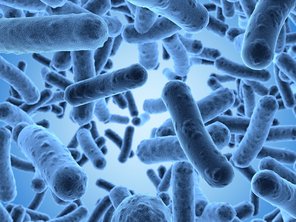INTESTINAL HEALTH
The gut - The centre of our wellbeing
Our gut is the largest interface in our body. With its numerous folds and convolutions, if spread out it would cover an area of 400–500 square metres. A great variety of substances find their way into our body via this enormous surface: nourishment and liquids, but also harmful substances. Our digestion is aided by microorganisms, in particular the intestinal bacteria. Around 100 billion bacteria populate our gut. In this guide you will learn more about this bacterial community, known also as the intestinal flora or the intestinal microbiome, and the role it plays in maintaining our health.
Here you will find information about these topics

Bacteria – The underrated all-rounders
Around 100 billion bacteria live in our gut and promote our health. Although many people tend to associate bacteria with dirt, the majority of bacteria are harmless – and may even be very useful. They are found throughout the body, although they are often invisible. Almost the entire body is colonized by bacteria. They are found on the body’s external interface – the skin – as well as deep within the lungs. The majority of bacteria are found in the gut, although not all bacteria live there for long. We absorb many bacteria with our food and excrete them again in our faeces a few days later. But there are also a great many bacteria that permanently colonize the gut. All the microorganisms together in the gut form the “intestinal flora” or “microflora”. Nowadays professionals refer to the intestinal microbiota. The aggregate of all bacteria that live in and on us is called the microbiome.
The bacteria that live in the gut are involved in many processes. Their metabolic products supply the human body with important vitamins (vitamin B12, folic acid, vitamin K, etc.). The bacterial population ensures regular digestion and nowadays we know that certain bacteria are important for us. The intestinal bacteria help to break down and process food: they break down indigestible nutritional components – such as dietary fiber – and produce essential vitamins and short-chain fatty acids such as butyric acid, which has an anti-inflammatory effect.
Even our brain can be affected by substances produced by the intestinal flora. There is a connection between the nerve cells in the gut and those in the brain. This network is called the “gut-brain axis”. A number of research groups throughout the world are currently engaged in clarifying which bacteria are specifically responsible for this connection and how this knowledge can be successfully employed in approaches to the treatment of neurological and mental health conditions.
OUR GUT
100 billion bacteria in the gut?
The gut is the largest organ in the human body; it winds its way through the middle of our body over a distance of up to eight meters.
The gut is divided into the small intestine, with a length of five to six meters, which is responsible for the absorption of all nutrients and leads into the large intestine, with a length of one and a half meters. In addition to the resorption of water, the large intestine condenses the partly digested food slurry and transports it to the anus.
Die einzelnen Abschnitte des Dünndarms nennen sich Zwölffingerdarm (Duodenum), Leerdarm (Jejunum) und Krummdarm (Ileum). In den etwa 30 Zentimeter langen Zwölffingerdarm münden der Gallengang und die Bauchspeicheldrüse. Aus der Gallenblase wird die Gallenflüssigkeit bei Bedarf abgegeben. Sie dient dazu, die Nährstoffe zu emulgieren - wasserlöslich zu machen - so dass sie von den Verdauungsenzymen, die u.a. in der Bauchspeicheldrüse gebildet werden, aufgespalten werden können. Als Endprodukte wird die Nahrung in verschiedene Zucker, Aminosäuren und Fettsäuren gespalten. Diese können dann in das Blut aufgenommen und an alle Zellen des Körpers als „Brennstoffe“ verteilt werden. Heute wissen wir, dass der Darm das größte Immunorgan des Menschen ist. Wir finden im Dünndarm ca. 80% aller immunogenen Zellen des menschlichen Körpers (Zellen, die an Immunvorgängen beteiligt sind). Der Durchmesser des Darms beträgt nur wenige Zentimeter, entfaltet weist er jedoch eine Oberfläche von 400 bis 600 Quadratmetern auf – das entspricht einer Größe von zwei Tennisplätzen. Diese große Oberfläche wird gebraucht, da die Resorptionsprozesse vom Darm in das Blut weitestgehend passiv über Konzentrationsunterschiede funktionieren und dafür wird eine, vor allem auf mikroskopischer Ebene, große Oberfläche benötigt.
6-8 Meter lang und dennoch 400-600 m2 Oberfläche? Und passen wirklich so viele Bakterien in den Darm?
Die Lösung ist genauso einfach wie genial: Die Darmschleimhaut ist stark gefaltet und dicht mit Zotten bestückt, die wie Millionen kleiner Finger (mikroskopisch klein) - Abbildung Rasterelektronenmikroskop - ins Darminnere ragen. Auf diese Weise wächst die Oberfläche um ein Vielfaches.
Zum Dickdarm gehört der Blinddarm - eine Aussackung am Beginn des Dickdarms, mit dem Wurmfortsatz. Der Blinddarm ist wichtig für Immunfunktionen und als Bakterien-Reservoir bei Durchfällen. Daran schließt sich der eigentliche Dick- oder Grimmdarm (Kolon) an, der in vier Abschnitte - aufsteigend, quer, absteigend und s-förmig - unterteilt ist. Den Abschluss bildet der 12 bis 15 Zentimeter lange End- oder Mastdarm (Rektum), der als Kotspeicher dient. Die Anzahl der Bakterien steigt im Verdauungstrakt vom Magen bis zum Dickdarm kontinuierlich an. Die wenigsten Bakterien finden wir im Magen – die meisten Bakterien hingegen im Dickdarm. Im Magen und den oberen Abschnitten des Dünndarms können wir überwiegend Bakterien nachweisen, die Sauerstoff vertragen können. Im Dickdarm finden wir keinen Sauerstoff, daher weisen wir hier überwiegend anaerobe Bakterien (Bakterien, die keinen Sauerstoff vertragen können) nach.
The intestinal flora acts as a natural barrier against pathogens, allergens and harmful substances.
The body’s natural protective barrier
Our gut has to deal with many substances that we take in from our environment on a daily basis. When we consume food and water, it is inevitable that many microorganisms, such as bacteria, fungi and viruses, as well as harmful substances also enter our digestive tract without us noticing. We need nutrients, dietary fiber and vitamins, etc., for the proper functioning of our body. We are not able to survive without them. Most of the bacteria we absorb are harmless or – as we have learnt already – important and useful for us. However, naturally there are also pathogenic bacteria and viruses or even harmful substances from the environment that find their way into our body. These must be rendered harmless and prevented from invading the body. Over the course of evolution, we have developed a highly efficient defense system against harmful substances, in which our good bacteria also play an important role. From an evolutionary viewpoint, the gut is an external surface of the body and the interface between the outside and the inside. When pathogenic bacteria and viruses enter the gut, a variety of effective defense mechanisms are available. The gut is covered with a mucous membrane which contains substances that prevent pathogens from attaching to the surface. Most pathogens are subsequently removed in the faeces. The good bacteria in our intestinal flora, which have lived in our body for a long time, assist in this defense by producing substances that kill pathogens (bacteriocins = antibiotics produced by bacteria). Certain probiotic bacteria in the intestinal flora also produce hydrogen peroxide, which has an inhibitory effect on many pathogens. In addition, some probiotic bacteria produce lactic acid, which makes the contents of the gut acidic and therefore keeps dangerous bacteria under control, as they cannot tolerate acidity.
The positive influence of the intestinal flora even extends beyond the gut. Around 80% of all immune cells are located in the gut.
ENEMIES OF THE INTESTINAL FLORA
Negative influences on intestinal health
Our “modern” way of life can damage the intestinal flora.
A poor diet with high-sugar, low-fiber foods
Medications, particularly antibiotics
Environmental hazards
Tension and negative stress
Smoking and excessive alcohol consumption
Bowel diseases
Negative influences can alter and impair the composition of the intestinal flora and lead to a leaky intestinal mucosa. Bacterial imbalance (dysbiosis) can have a negative impact on the body. The consequences of this are a vitamin imbalance and weakened immune system which can result in various diseases. These include irritable bowel syndrome and recurrent inflammatory bowel diseases. But even conditions that at first glance apparently have nothing to do with the gut may be associated with changes to the intestinal flora and the immune system, which can be influenced by the gut. These include allergic conditions, for example, but also recurrent infections of the upper and lower respiratory tract.
New findings show: the intestinal flora also has a significant impact on metabolic processes in humans. The short-chain fatty acids (in particular butyric acid) produced by the intestinal bacteria can affect insulin production, as well as the capacity of the body’s cells to absorb insulin.
Unbelievable but true: our good bacteria can even have a positive influence on the feeling of hunger or fullness, with the result that body weight and insulin resistance can thereby be reduced. Many research projects are currently focused on investigating the influence of certain probiotic bacteria on the disease course and possible prevention of type 2 diabetes.
